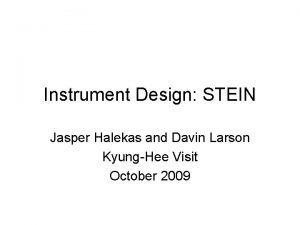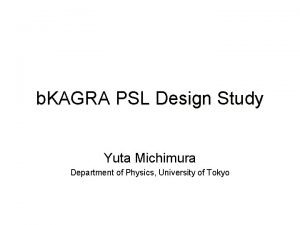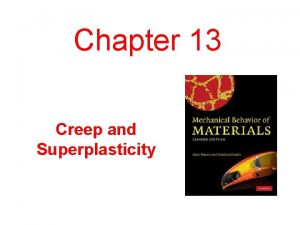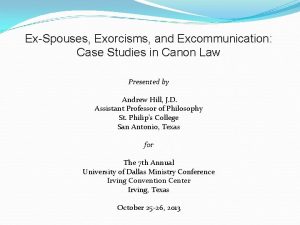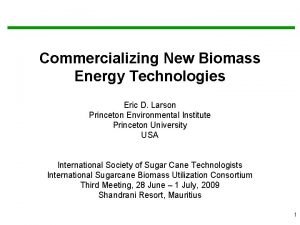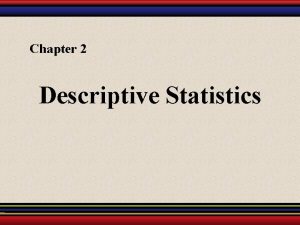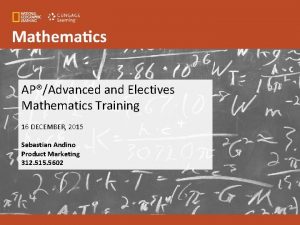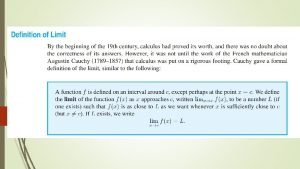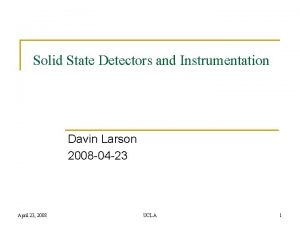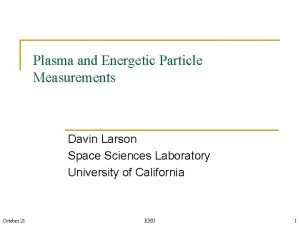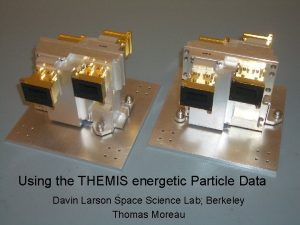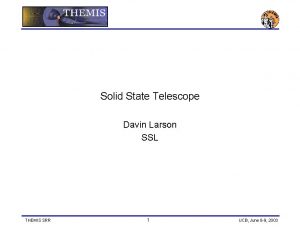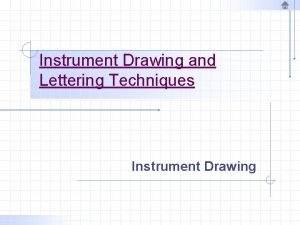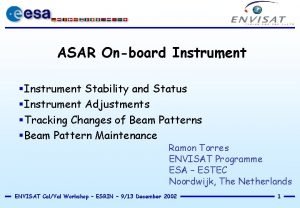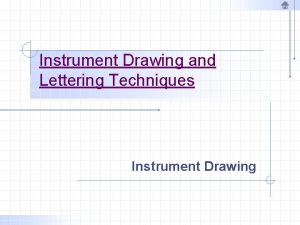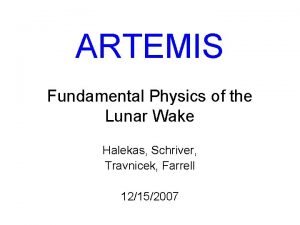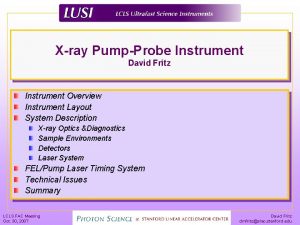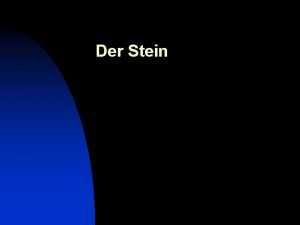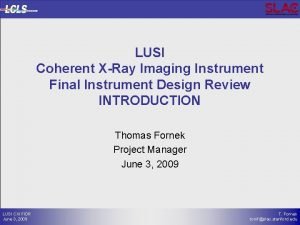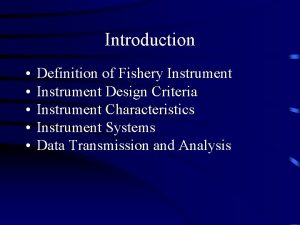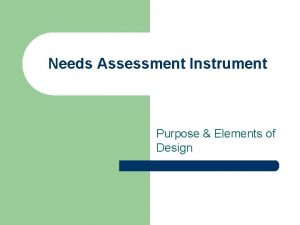Instrument Design STEIN Jasper Halekas and Davin Larson


























- Slides: 26

Instrument Design: STEIN Jasper Halekas and Davin Larson Kyung-Hee Visit October 2009

Space Physics Instrumentation • Usually want to: – Maximise sensitivity – Maximise energy/angular resolution and coverage – Minimize weight/power – Separate different species of charged particles (and sometimes neutrals!)

Electrostatic Analyzer • Separates species very well, has very good energy/angular resolution • Low sensitivity, because of small geometric factor and need to sweep energy/angle • Can only measure one species in each detector

STEREO STE (Supra. Thermal Electrons) » Prototype detector • Very good sensitivity • Measures all energies simultaneously • Can measure ions, electrons, neutrals • But - have to have some way to separate species! • Thin window detector, very sensitive electronics, allows measurements to a few ke. V (few ke. V low energy threshold unprecedented for solid state detectors!)

er k r al a P pir ns S ctro e El STE-U w/FOV and Preamp Mounts to side of IMPACT Boom Field of view along Parker spiral – with solar wind out of FOV STE-U 70 x 70 STE-U FOV Solar Wind Ions

THEMIS SST Energy range > ~20 ke. V, electrons and ions separated

Basic design of SST instrument Al/Polyamide/Al Foil (stops ions <400 ke. V) Foil Collimator Attenuator Foil Detector Thick Detector Open Collimator Attenuator Sm-Co Magnet (sweeps away electrons <400 ke. V)

Foil Separation Energy Proton Projected Range Electron Projected Range 1 ke. V 3 x 10 -6 g/cm 2 2 ke. V 6 x 10 -6 g/cm 2 1 x 10 -5 g/cm 2 5 ke. V 1. 5 x 10 -5 g/cm 2 5. 4 x 10 -5 g/cm 2 10 ke. V 2. 7 x 10 -5 g/cm 2 1. 8 x 10 -4 g/cm 2 20 ke. V 4. 6 x 10 -5 g/cm 2 6 x 10 -4 g/cm 2 50 ke. V 9. 5 x 10 -5 g/cm 2 3 x 10 -3 g/cm 2

Toolchest 1: Interactions w/ Matter CASINO = " monte CArlo SImulation of electro. N trajectory in s. Olids "

Magnetic Deflection 1 cm B = 500 G X 2 cm pixelated (8 x 8) detector • Energy Range 2 ke. V – 50 ke. V (full angular coverage), Angular Range ± 30°. • Partial angular coverage for higher energies. • Poor angular resolution for lowest energies.

Magnetic Deflection

Magnetic Deflection

Toolchest 2: Finite Element Magnetostatics • Define a discrete grid and solve for the magnetic potential from each element • Linghua Wang used a commercially available program for this work

Toolchest 3: Tracing Particles The Lorentz Force Law provides the second order differential equation of motion for charged particles. We use the 4 th order Runge-Kutta method with an adaptive time step to solve this ordinary differential equation

Electrostatic Deflection 2 cm E-Field Region 4 2 2 cm 3 Electrons Ions W 1 L

Top View 5 cm 2 cm High Energy Ions and Electrons 3 cm Ions 4 mm Electric Field Region E = 100 -1000 V/mm Electrons Side View

Ion Pixel Electron Pixel High Energy Pixel Electrons Ions E = 100 V/mm V = 400 V

Realistic Potential Distribution

Toolchest 4: Finite Difference Electrostatics • We set the electrostatic potential of electrodes/deflectors • Then, in free space, the potential must satisfy Laplace’s equation • Davin Larson wrote code to solve on a grid using a finite difference method

Particle Trajectories in Realistic Potential Distribution

Trajectories: Collimators Electrostatic Deflectors Pixelated Detectors (Mounted Back-to-Back) 5 cm Solar Orbiter STE Low Energy Electrons Low Energy Ions Neutrals, High Energy Electrons and Ions

Energy-Angle Response for Edge Pixels

Energy-Angle Response for Middle Pixels

Center Pixel Response (Electrons) Edge Pixel Response (Electrons) Deflection Voltage Left Sweep 4 k. V 1. 5 k. V Right Sweep 600 0 600 1. 5 k. V 4 k. V • Symmetric response for ions • Neutrals measured in center pixel – cleanly separated for energies below ~15 -20 ke. V • Logarithmic voltage sweep with ten steps from 600 V to 4 k. V is optimal for covering phase space. Need positive and negative sweeps to get all angles, so 20 voltage steps desired.

Telemetry • For edge pixels need 20 voltage steps – To deconvolve, prefer linear energy bins from 2 -15 ke. V (no need to go higher for edge pixels) – Total sweep = 20 V*14 E*8 pixels*8 bits = 17920 bits • For center pixels, can sum all voltage steps (not true if you want to do neutrals). – Need 20 logarithmic energy bins to cover 3 -100 ke. V at energy resolution of 0. 2 – Total distribution = 20 E*8 pixels*8 bits = 1280 bits • Total instrumental bits per sweep = 19200 – 200 bps gives 96 s Time Resolution • For CINEMA, Time Tag all Events

Total Instrumental Count Rates at 1 AU (scale up by 25? at 0. 2 AU) Shows need for Attenuator for Solar Orbiter Similar Issue for Auroral Zone for CINEMA Quiet Time Un-Attenuated Big SEP Event Un-Attenuated Red = Edge Pixel Black = Middle Pixel Quiet Time Attenuated Big SEP Event Attenuated
 Jasper halekas
Jasper halekas Jasper johns map 1963
Jasper johns map 1963 Jasper design automation
Jasper design automation Property specification language
Property specification language An passive instrument is
An passive instrument is Larson-miller parameter ppt
Larson-miller parameter ppt Jj larson
Jj larson Brynne larson
Brynne larson Eric larson princeton
Eric larson princeton Clifton larson allen
Clifton larson allen Class mark in statistics
Class mark in statistics Larson calculus.com
Larson calculus.com Dr julie larson
Dr julie larson Desiree larson
Desiree larson Larson precalculus.com
Larson precalculus.com Ardiolate
Ardiolate Ron larson
Ron larson Julie larson lcsw
Julie larson lcsw West 8 landscape architecture
West 8 landscape architecture Gray larson
Gray larson Dr larry larson
Dr larry larson Clifton larson allen
Clifton larson allen Jasper and sardius stone
Jasper and sardius stone Jasper coleman
Jasper coleman The adventures of jasper woodbury
The adventures of jasper woodbury Jasper private equity
Jasper private equity Jasper ikea
Jasper ikea
